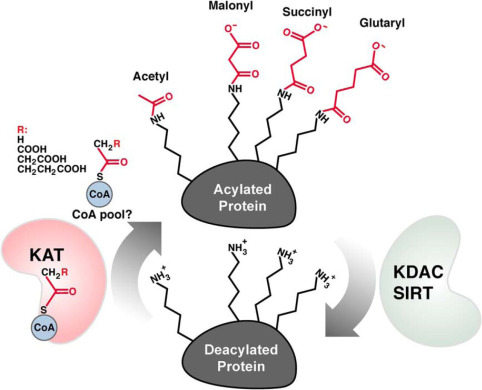Malonylation Analysis Service
Malonylation, as a newly discovered type of acylation modification in recent years, has an important role in metabolic processes, especially energy metabolism, inflammatory response and photosynthesis. Creative Proteomics offers high-quality malonylation analysis services, including identification, quantification and characterization of protein malonylation modifications, providing valuable insights into your protein research.
What is Malonylation
Malonylation is an evolutionarily conserved type of protein post-translational modification (PTM) occurring on lysine that was first identified in 2011. It occurs in dependence on the transfer of a negatively charged malonyl group from malonyl-CoA to the positively charged ε-amino group of lysine. Like many other acyl-CoA species, malonyl-CoA is an intermediate metabolite of the fatty acid synthesis pathway and is an endogenous provider of the malonyl group required for lysine malonylation. Modification of acyl-CoA can occur by enzymatic or nonenzymatic pathways, but acylation in mitochondria is generally considered to be nonenzymatic.

Fig.1 Schematic of malonylation (Hirschey, M. D.; Zhao, Y.; 2015)
Malonylation alters the electrostatic interactions of lysine with other amino acids and its protein conformation, and may even affect its binding to target proteins. Malonylation has been shown to be present in a variety of metabolic pathways such as fatty acid synthesis and, mitochondrial respiration, glycolysis, plant stress tolerance, inflammatory response, photosynthesis, and others. Malonylation, as a widespread PTM, plays a crucial role in protein and biological process research, among others.
Applications of Malonylation Analysis
Inflammatory Reaction
Investigating the role and mechanisms of malonylated proteins in the inflammatory response and probing the physiological processes of the inflammatory response.
Metabolic Regulation
Explore how malonylation influences metabolic pathways and enzymes, particularly its role in energy metabolism and nutrient sensing.
Photosynthesis
Research on the effects and regulatory mechanisms of malonylation during photosynthesis and an in-depth study of plant stress tolerance.
Malonylation usually occurs in mitochondria and plays an important role in many aspects of mitochondrial respiration, glycolysis, diabetes, as well as plant photosynthesis and stress tolerance studies. Protein malonylation is an important aspect of biological and pharmaceutical research that should not be ignored and has a wide range of applications.
Our Service
Creative Proteomics has advanced protein detection technologies and can provide customized services to researchers and scientists to help them reveal the complexity of PTM using powerful mass spectrometry technologies. Our services are thoughtful and detailed and the process of malonylation analysis service is as follows:

Fig.2 Malonylation analysis workflow
- Sample Preparation
Proper extraction and preparation of proteins from biological samples to ensure preservation of malonylated proteins. - Malonylation Enrichment
Enrichment techniques are employed to isolate malonylate proteins or peptides. This step is crucial as malonylation modifications are often present in low abundance compared to unmodified proteins. - Detection
WB, protein microarrays and LC-MS/MS are powerful tools for the identification and quantification of malonylate peptides, and they provide detection information that facilitates a comprehensive analysis of malonylation. - Bioinformatics Analysis
Advanced bioinformatics tools are used to analyze data, identify malonylate peptides, and map these modifications to protein sequences. - Result Delivery
After professional data analysis, we deliver results quickly and consistently.
Creative Proteomics brings a wealth of experience to the field of protein research. Our comprehensive services and products cover the entire spectrum of utilizing suitable and efficient gateways. Utilizing our proprietary platform, we have successfully implemented many proteomics research projects. If you are interested, please contact us for more information and a quote.
Reference
- Hirschey, M. D.; Zhao, Y. Metabolic Regulation by Lysine Malonylation, Succinylation, and Glutarylation. Molecular & Cellular Proteomics. 2015, 14(9): 2308-2315

